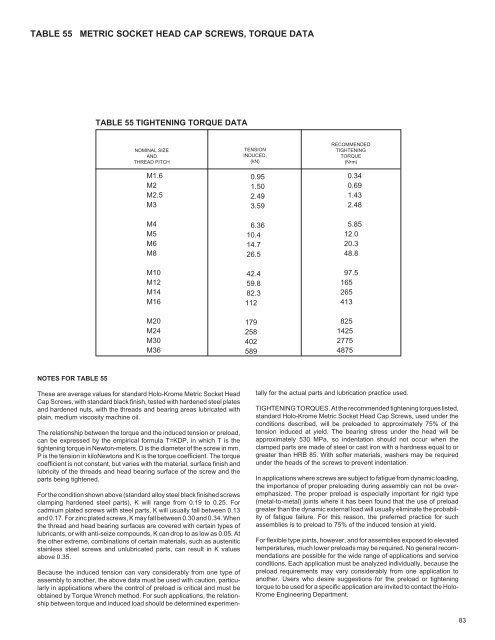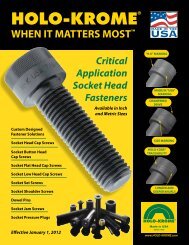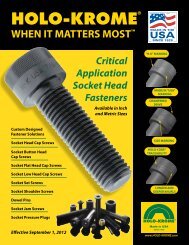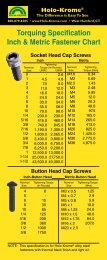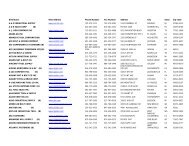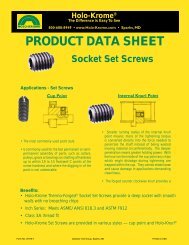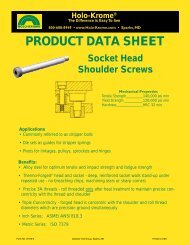Consolidated Tech Man - Holo-Krome
Consolidated Tech Man - Holo-Krome
Consolidated Tech Man - Holo-Krome
Create successful ePaper yourself
Turn your PDF publications into a flip-book with our unique Google optimized e-Paper software.
TABLE 55 METRIC SOCKET HEAD CAP SCREWS, TORQUE DATA<br />
NOTES FOR TABLE 55<br />
TABLE 55 TIGHTENING TORQUE DATA<br />
NOMINAL SIZE<br />
AND<br />
THREAD PITCH<br />
M1.6<br />
M2<br />
M2.5<br />
M3<br />
M4<br />
M5<br />
M6<br />
M8<br />
M10<br />
M12<br />
M14<br />
M16<br />
M20<br />
M24<br />
M30<br />
M36<br />
These are average values for standard <strong>Holo</strong>-<strong>Krome</strong> Metric Socket Head<br />
Cap Screws, with standard black finish, tested with hardened steel plates<br />
and hardened nuts, with the threads and bearing areas lubricated with<br />
plain, medium viscosity machine oil.<br />
The relationship between the torque and the induced tension or preload,<br />
can be expressed by the empirical formula T=KDP, in which T is the<br />
tightening torque in Newton-meters, D is the diameter of the screw in mm,<br />
P is the tension in kiloNewtons and K is the torque coefficient. The torque<br />
coefficient is not constant, but varies with the material, surface finish and<br />
lubricity of the threads and head bearing surface of the screw and the<br />
parts being tightened.<br />
For the condition shown above (standard alloy steel black finished screws<br />
clamping hardened steel parts), K will range from 0.19 to 0.25. For<br />
cadmium plated screws with steel parts, K will usually fall between 0.13<br />
and 0.17. For zinc plated screws, K may fall between 0.30 and 0.34. When<br />
the thread and head bearing surfaces are covered with certain types of<br />
lubricants, or with anti-seize compounds, K can drop to as low as 0.05. At<br />
the other extreme, combinations of certain materials, such as austenitic<br />
stainless steel screws and unlubricated parts, can result in K values<br />
above 0.35.<br />
Because the induced tension can vary considerably from one type of<br />
assembly to another, the above data must be used with caution, particularly<br />
in applications where the control of preload is critical and must be<br />
obtained by Torque Wrench method. For such applications, the relationship<br />
between torque and induced load should be determined experimen-<br />
TENSION<br />
INDUCED,<br />
(kN)<br />
0.95<br />
1.50<br />
2.49<br />
3.59<br />
6.36<br />
10.4<br />
14.7<br />
26.5<br />
42.4<br />
59.8<br />
82.3<br />
112<br />
179<br />
258<br />
402<br />
589<br />
RECOMMENDED<br />
TIGHTENING<br />
TORQUE<br />
(N•m)<br />
0.34<br />
0.69<br />
1.43<br />
2.48<br />
5.85<br />
12.0<br />
20.3<br />
48.8<br />
97.5<br />
165<br />
265<br />
413<br />
825<br />
1425<br />
2775<br />
4875<br />
tally for the actual parts and lubrication practice used.<br />
TIGHTENING TORQUES. At the recommended tightening torques listed,<br />
standard <strong>Holo</strong>-<strong>Krome</strong> Metric Socket Head Cap Screws, used under the<br />
conditions described, will be preloaded to approximately 75% of the<br />
tension induced at yield. The bearing stress under the head will be<br />
approximately 530 MPa, so indentation should not occur when the<br />
clamped parts are made of steel or cast iron with a hardness equal to or<br />
greater than HRB 85. With softer materials, washers may be required<br />
under the heads of the screws to prevent indentation.<br />
In applications where screws are subject to fatigue from dynamic loading,<br />
the importance of proper preloading during assembly can not be overemphasized.<br />
The proper preload is especially important for rigid type<br />
(metal-to-metal) joints where it has been found that the use of preload<br />
greater than the dynamic external load will usually eliminate the probability<br />
of fatigue failure. For this reason, the preferred practice for such<br />
assemblies is to preload to 75% of the induced tension at yield.<br />
For flexible type joints, however, and for assemblies exposed to elevated<br />
temperatures, much lower preloads may be required. No general recommendations<br />
are possible for the wide range of applications and service<br />
conditions. Each application must be analyzed individually, because the<br />
preload requirements may vary considerably from one application to<br />
another. Users who desire suggestions for the preload or tightening<br />
torque to be used for a specific application are invited to contact the <strong>Holo</strong>-<br />
<strong>Krome</strong> Engineering Department.<br />
83


